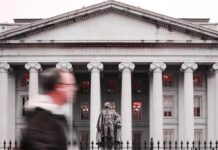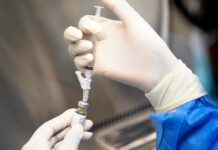Yesterday’s order would go much further than Trump’s previous promises on this topic.
This is the gist: For certain high-cost drugs with few competitive alternatives, the government’s Medicare program would pay drugmakers the lowest price paid by any country in the Organization for Economic Cooperation and Development with a gross domestic product comparable to the United States. Theoretically, this would lower drug prices in the U.S., where the pharmaceutical industry doesn’t face government price controls that many European countries have instituted.
The order directs the secretary of health and human services to test how the approach would work both for drugs administered in doctor’s offices (through Medicare Part B) and for drugs seniors buy from pharmacies (through Medicare Part D) “where insufficient competition exists” and they have to pay prices above those of OECD-member countries. The tests would be conducted through what are known as “demonstration projects.”
This goes beyond an approach Trump originally outlined in November 2018. He initially said the new payment approach would apply only to Part B drugs. A subsequent executive order that he announced in July also mentioned only Part B.
But Sunday’s executive order — which replaces the July executive order — would also apply to Part D, which covers the vast majority of drugs prescribed to seniors.
Donna Young, senior reporter for S&P Global News:
Trump had been hyping this latest announcement for weeks.
The president has long wanted to declare a win in lowering U.S. drug prices, which are generally much higher than in any other developed country. He doesn’t need to issue executive orders for his administration to start experimenting with new Medicare payments — but he clearly wants to be able to claim he’s doing something on drug prices ahead of Nov. 3. He has repeatedly said his administration will issue a new health-care plan to repeal and replace the Affordable Care Act, but that has not been forthcoming.
It’s unclear whether and when HHS might move forward on implementing the policy, which would involve a limited number of Medicare payments and could last only five years. The agency never proposed rules on it, despite Trump’s repeated promises, and the pharmaceutical industry is likely to sue.
Larry Levitt, senior vice president at the Kaiser Family Foundation:
The Pharmaceutical Research and Manufacturers of America criticized the administration’s broadening of the proposal in a statement issued by PhRMA chief executive Stephen Ubl.
“They are now expanding the policy to include medicines in both Medicare Part B and Part D, an overreach that further threatens America’s innovation leadership and puts access to medicines for tens of millions of seniors at risk,” he said.
The U.S. Chamber of Commerce also slammed the move.
“The extent of U.S. leadership in bio-pharmaceutical research and development has never been more evident or important than in the covid-19 pandemic,” Chief Policy Officer Neil Bradley said in a statement. “Importing price controls from foreign countries is flawed and dangerous policy that will result in a substantial reduction in investment in new cures and drugs at the worst possible time.”
Trump’s promises to lower drug prices in the Medicare program have gone through several iterations.
In 2018, Trump said Medicare would experiment with tying Part B prices to an international index. Prices would be based on the average price paid by countries in the index. But HHS never proposed rules and the idea stalled.
Then, in July, Trump announced four executive orders related to high drug prices. This is where he proposed “the most favored nations” approach over his previous idea of an international index. This latest order, the broadest of all, would involve both Medicare Parts B and D.
Ahh, oof and ouch
AHH: AstraZeneca resumed its trial in the U.K., but researchers want more information from vaccine makers.
While it’s standard for drug companies to withhold details of clinical trials until they are completed, “there is a growing outcry among independent scientists and public health experts who are pushing the companies to be far more open with the public,” the New York Times’s Katie Thomas reports.
AstraZeneca failed to notify the public when it first halted the trial last week. The news emerged instead from reports on a speech that the company’s chief executive gave during a closed meeting by J.P. Morgan, the investment bank.
AstraZeneca resumed its vaccine trial on Saturday in the United Kingdom, although it remains suspended in the United States and other countries. The trial resumed on the recommendation of an independent safety review committee and the U.K. health regulator, but the company still has not provided details about the patient’s medical condition, citing safety concerns.
Similarly, when Pfizer announced a major expansion of its own vaccine trial this weekend, it provided few details about its plan, Thomas writes.
“We’ve never had such an important clinical trial — or series of clinical trials — in recent history,” Eric Topol, a professor of molecular medicine at Scripps Research in La Jolla, Calif., and an expert on clinical trials, told Thomas. “Everything should be transparent.”
OOF: Trump officials sought more control over CDC reports on the coronavirus.
Trump-appointed HHS communications aides have made persistent and at times successful attempts to edit weekly coronavirus reports by the Centers for Disease Control and Prevention over concerns they would undermine the president’s message on the U.S. response to the pandemic.
“Michael Caputo, the top HHS spokesman, said in an interview Saturday that he and one of his advisers have been seeking greater scrutiny of the CDC’s weekly scientific dispatches, known as the Morbidity and Mortality Weekly Report, for the past 3½ months,” The Post’s Lena H. Sun writes. “The adviser, Paul Alexander, has sent repeated emails to the CDC seeking changes and demanding that the reports be halted until he could make edits.”
“CDC to me appears to be writing hit pieces on the administration,” Alexander wrote in one of the emails, which were first reported by Politico. Caputo confirmed the authenticity of the emails, Sun writes.
The CDC rejected requests by Alexander to review Morbidity and Mortality Weekly Reports, key publications by which the nation’s premiere public health agency communicates with scientists and public health specialists, in their entirety before publication.
OUCH: Anthony Fauci, head of the National Institute for Allergy and Infectious Diseases, cautioned that a return to normal could be a year away.
“If you’re talking about getting back to a degree of normality prior to COVID, it’s going to be well into 2021, towards the end be of 2021,” Fauci said in an interview with MSNBC’s “Andrea Mitchell Reports” on Friday.
Even if a vaccine is developed before the end of the year, the process of distributing it and getting the majority of people vaccinated will take the nation until the middle or end of next year, the top infectious-disease doctor said.
Fauci also disputed Trump’s claim – made in a speech in Michigan on Thursday – that the country is turning the corner on coronavirus cases.
“I have to disagree with that,” Fauci said. The United States is averaging 40,000 cases a day. “You don’t want to start off already with a baseline that’s so high” going into fall and winter, Fauci said, raising concerns that the cooler weather will lead people to spend more time indoors where it is easier to spread respiratory viruses.
Biden’s coronavirus plans
Biden is preparing his strategy for the pandemic should he win in November.
“Joe Biden has created a war-cabinet-in-waiting on the coronavirus pandemic, with major figures from the Obama, Clinton and George H.W. Bush administrations drafting plans for distributing vaccines and personal protective gear, dramatically ramping up testing, reopening schools and addressing health-care disparities,” The Post’s Yasmeen Abutaleb and Laurie McGinley report.
David Kessler, a former Food and Drug Administration commissioner under Presidents George H.W. Bush and Bill Clinton, and Vivek H. Murthy, surgeon general under President Barack Obama, have been working with a group of volunteer experts to craft Biden’s plan for confronting the pandemic if he takes office on Jan. 20.
Biden has said that he would push a massive ramp-up in testing, urge state and local officials to institute mask mandates and outline plans to distribute vaccinations, once approved. But experts warn that partisan divides and widespread disinformation could pose challenges to even the best-laid plans.
Coronavirus latest
- Testing for lead poisoning among children has plummeted as many families are skipping or delaying pediatric appointments because of the pandemic, Kaiser Health News’s Brie Zeltner reports.
- North Dakota and South Dakota are leading the country in new cases per capita over the past two weeks, even as both states reject mask mandates. South Dakota’s positivity rates for coronavirus tests are over 17 percent — some of the highest rates in the country and a sign that the state is missing many infections, the Associated Press’s Stephen Groves and Dave Kolpack report.
- The World Health Organization reported a record one-day increase in global coronavirus cases on Sunday, with the biggest increases coming from India, the United States and Brazil, Reuters reports.
The links between health and environment
New research links covid-19 outcomes to hazardous air pollutants.
“The type of pollution emitted by many chemical plants in Louisiana’s industrial corridor is correlated with increased coronavirus deaths,” Lylla Younes and Sara Sneath write for ProPublica, based on findings from a peer-reviewed study conducted by the investigative journalism nonprofit and the State University of New York (SUNY).
The research published Friday in the journal Environmental Research Letters found a correlation between levels of hazardous air pollutants and the coronavirus death rate across 3,100 counties in the United States.
Hazardous air pollutants are defined by the Environmental Protection Agency as chemicals likely to cause cancer or other serious health problems. They are emitted by chemical plants in Louisiana’s industrial corridor, which could explain a high death rate from the virus in this area, ProPublica reports.
The type of pollutants measured in the study are distinct from, but frequently found along with, particulate air pollution, which has been the subject of earlier research that also linked pollution to worse covid-19 outcomes. Some of these earlier studies, however, were not peer reviewed and have faced pushback from the EPA, as well as from some scientists who objected to the lack of formal review and questioned whether it was possible to draw a strong link without individualized health data.
Pollution from wildfires on the West Coast is spreading far beyond the fire zones — and causing serious health problems.
“The health effects of wildfire smoke are not fully understood, and the particles differ in some ways from other air pollution, which has been shown to cause disease,” the New York Times’s Nicole Perlroth and John Schwartz report. “But wildfire smoke, which can include toxic substances from burned buildings, has been linked to serious health problems.”
This smoke from wildfires is of particular concern during the coronavirus pandemic. The CDC has warned that people with covid-19 are at increased risk from wildfire smoke.
“Studies have shown that, when waves of smoke hit, the rate of hospital visits rises and many of the additional patients experience respiratory problems, heart attacks and strokes,” Perlroth and Schwartz write.
Smoke exposure could also have lifelong impacts on babies whose lungs are still developing. It also disproportionately impacts people of color who already live in areas more likely to suffer from pollution.
Even after the smoke clears, its effects may linger. One study found that after bad wildfires, Montana saw worse influenza seasons months later.
Californians wonder if the California dream is still possible in a state hard-hit by the coronavirus pandemic and natural disasters.
The coronavirus pandemic has killed 14,000 people in California, as residents grapple with record heat and wildfires that have affected nearly every region of the state. The crises come as some Californians were already leaving for other reasons, including the high cost of living: Last year, more people left California than moved to the state for the first time in a decade.
“For many of the state’s 40 million residents, the California Dream has become the California Compromise, one increasingly challenging to justify, with a rapidly changing climate, a thumb-on-the-scales economy, high taxes and a pandemic that has led to more cases of the novel coronavirus than any other state,” The Post’s Heather Kelly, Reed Albergotti, Brady Dennis and Scott Wilson write.
Both the fires and the coronavirus pandemic have revealed inequities in the state, showing who can afford to leave or find ways to live safely and comfortably and who cannot.
“Latinos account for 61 percent of coronavirus cases, an infection rate disproportionately high given that they make up just 35 percent of the overall state population. Many are the ‘essential workers’ serving food, picking crops and living lives that are not privileged enough to take refuge in the safety of telecommuting,” Kelly, Albergotti, Dennis and Wilson write.
In other news
Protesters showed up at an L.A. hospital where two police officers are being treated after being shot.
The two deputies underwent surgery on Saturday evening after they were shot while sitting in their patrol car in Compton, Calif., by an unidentified gunman described as Black who approached the parked car and shot through the passenger window, the Associated Press’s Christopher Weber reports.
“A handful of protesters gathered outside the hospital where the injured deputies were being treated. The protesters tried to provoke deputies stationed outside and at one point were prevented from entering the emergency room, Bishop Juan Carlos Mendez with the Churches in Action group told the TV station KABC,” Weber writes.
The Los Angeles County Sheriff’s Department tweeted early Sunday morning that protesters had blocked hospital entrances and exits and were shouting, “We hope they die.”
The account of the blocked entrances has faced some scrutiny. “Video showed only a handful of men outside, some taking video on their phones,” Weber reports.
Police arrested one protester who they said failed to disperse, as well as Josie Huang, a reporter for public radio station KPCC. Police claim she did not follow orders, but she said on Twitter that she tried to comply and identified herself as a reporter.








